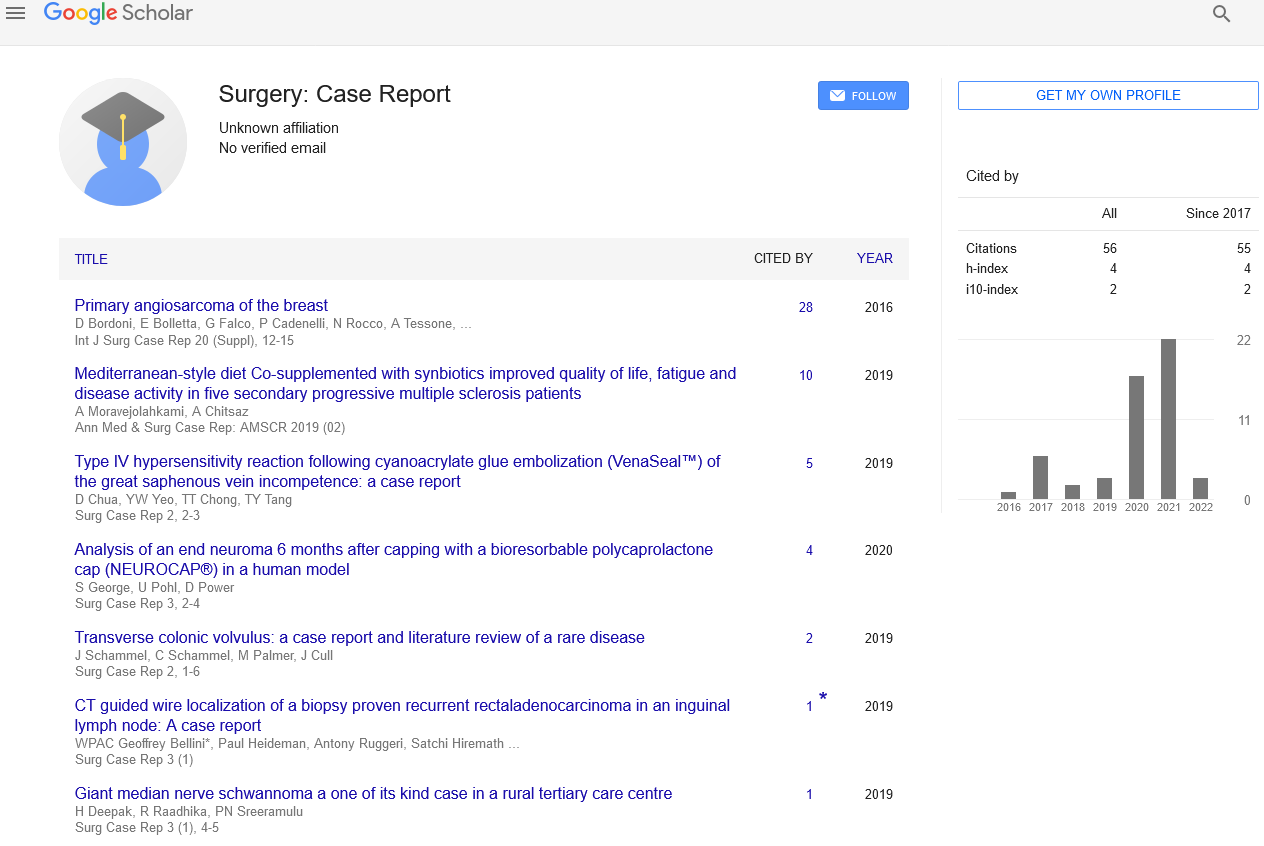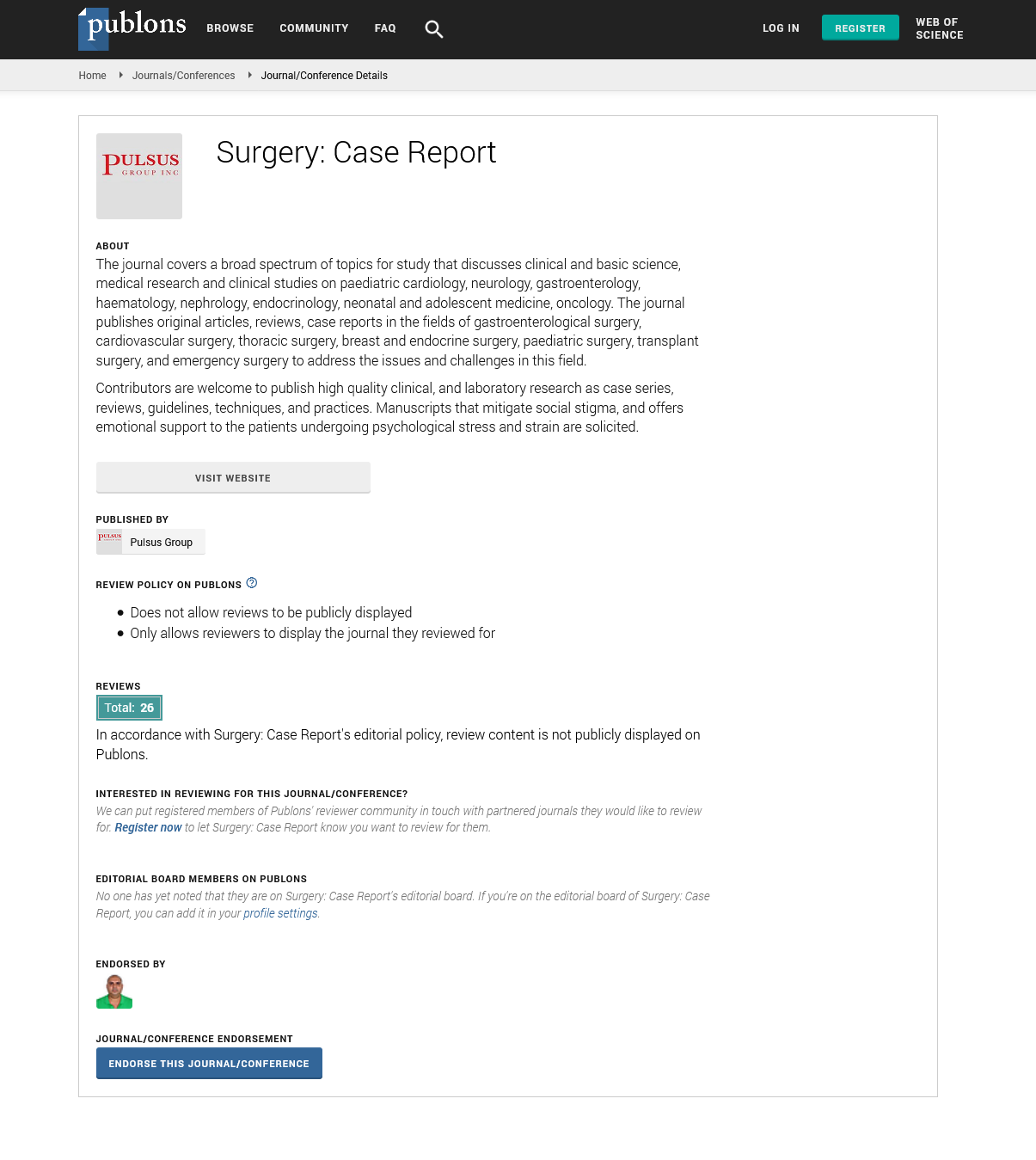Advantages and Drawbacks of Surgery in Treatment of Gastro Esophageal Reflux: An Overview
Received: 07-Jul-2021 Accepted Date: Jul 18, 2021; Published: 25-Jul-2021
Citation: Kumar P. Advantages and Drawbacks of Surgery in Treatment of Gastro Esophageal Reflux: An Overview. Surg Case Rep. 2021; 5(4):3.
This open-access article is distributed under the terms of the Creative Commons Attribution Non-Commercial License (CC BY-NC) (http://creativecommons.org/licenses/by-nc/4.0/), which permits reuse, distribution and reproduction of the article, provided that the original work is properly cited and the reuse is restricted to noncommercial purposes. For commercial reuse, contact reprints@pulsus.com
Editorial
Gastro Esophageal Reflux Disease (GERD) is common: in 2006, the total prevalence in France was 31%, with 7.8% of the population suffering from GERD with frequent bouts of reflux. Whenever medication fallen short, surgery were suggested. Fundoplication or entire duodenal diversion (partial gastrectomy and Roux-en-Y gastrojejunostomy) through laparotomy were commonly the procedures used during those times. The introduction of proton pump inhibitors (PPIs) in the 1980s was an enormous turning point, because this treatment allowed better control of acid secreted Proton pump inhibitors (PPIs) were introduced in the 1980s, and they were a huge step forward since they permitted effective performance of acid secretion and were far more successful than Histamine-2 receptor blocker-based medicine. Finally, there had been a viable treatment for pyrosis, and as a result, the need for surgery fell significantly. The introduction of proton pump inhibitors (PPIs) changed the way GERD was treated.
The fervor for laparoscopy that swept the United States in the 1990s could not save GERD surgery. Patients took so-called minimally invasive surgery better, the post-operative course was shorter and less painful, and the number of surgical cases rose enormously. Rampall’s operation and the Angelchik prosthesis, both of which had previously proven demonstrated to be useless, were reintroduced under the guise that they could be executed even more readily via laparoscopy. Surgical procedures proliferated at the first sign of GERD, either conventional or otherwise, with sometimes unwarranted diagnoses and faulty methodologies. The results were frequently poor, involving drastic and even deadly consequences like esophageal perforations. Such outcomes proved difficult to comprehend for functional surgery, and it gravely damaged gastroenterologists’ and patients’ faith in the procedure. PPIs functioned almost as well as surgery in a Swedish research, indicating that treatment for GERD was no longer necessary. The results of this multicenter research comparing anti-secretory medication versus total fundoplication in terms of GERD management were equivalent; however fundoplication frequently resulted in overcorrection. However, the PPIs seemed to have a lot of benefits and no side effects.
Through the decade of the 2010s, endoscopists developed and tested endolumenal antireflux treatments, including ambitious fundoplication techniques facilitated by a sophisticated endolumenal suturing device or radioablation at the level of the lower esophageal sphincter (LES). The promised outcomes were just not proven, so these procedures were never widely adopted: PPIs maintained the preferred therapy for GERD, for daily use for a long time. Enhanced understanding of the process of GERD, particularly the significance of LES transient relaxations, resulted towards the recommendation GABA receptor agonist, as a therapy. Nevertheless, despite being successful and ideally tailored towards the physiopathology of GERD, the above approach had so many adverse reactions, especially neurological, to be used on a regular basis. Similarly, prokinetic therapy, which is supposed to speed up stomach emptying and alleviate GERD symptoms, hasn’t been proven to work. PPIs won out in the end, and they are still the preferred therapy for GERD. The advantages for laparoscopic fundoplication surgery to treat GERD are now confined to certain circumstances: poor responses to PPIs, particularly continuation of food regurgitations, PPI-dependent GERD in patient, or PPI-refractory GERD.
Initially PPIs had many beneficial aspects that were promoted, but no adverse effects are discovered; however, as time progresses, side effects are documented, and treatment restrictions emerge. PPIs have held up relatively well, owing to the introduction of second-generation PPIs like esomeprazole, which appears to be more active than the original omeprazole. Finally, the negative impacts are identified. Reduced acid-dependent calcium absorption was the first of these. PPI use for a long time increases the risk of osteoporosis and femoral neck fractures. Kidney failure, galactorrhea, and hyperplastic gastric polyps have all been documented as side effects. PPIs should not be prescribed long-term for such causes, particularly for women who have reached menopause. Finally, not all PPI effects are beneficial.
The conventional reasons for GERD surgery have resurfaced on stage: PPIdependent GERD, moderately successful medical treatment with chronic positional regurgitation, and failure of medical treatment. The occurrence of esophagogastric junction adenocarcinoma, has added to the severity of the problem. Controlling GERD lowered, but did not entirely eradicate, the chance of Barrett’s esophagus malignancy. Fundoplication, whether partial or complete, is still the primary treatment for GERD. The effectiveness of these two techniques was found to be similar in two meta-analyses. Partial fundoplication, on the other hand, has less adverse effects. Peri-esophageal magnetic sphincter augmentation, utilizing a laparoscopically implanted device became another effective treatment option. Despite the fact that it is not yet accessible, this device has been thoroughly evaluated, with positive actual and perceived outcomes. This might be a straightforward and successful remedy for GERD, especially after SG, when fundoplication is not feasible then the only other alternative is to convert the SG to a Roux-en-Y gastric bypass.
Even so, potent anti-surgery necessitates accurate indications, as well as patient selection through a customized pre-operative workup that includes high-resolution esophageal manometry to rule out esophageal motor disorders, endoscopy, and pH-metry or impedance pH-metry anytime GERD characteristics aren’t really common. The surgical method is ought to be meticulous: the fundoplication must be at least 3 cm long, tension-free, and include crucial repair. For individuals with PPI resistant heartburn, the fundoplication was better to medication therapy. Only a small percentage of patients with PPI-refractory heartburn had proven reflux, over which surgery seems to be the effective treatment choice. In other words, thorough pre-therapeutic evaluation ruled out a large percentage of patients who didn’t have true GERD. This emphasizes the importance for surgeons to comprehend the disease, its usual and exceptional presentations, as well to be able to analyse the pre-therapeutic workup accurately. This is critical for accurate GERD surgery justifications and favourable outcomes. As a result, it is critical that surgeons, or at least a group of surgeons, rekindle their interest in this common condition, which has been neglected for some time but is now very relevant.






